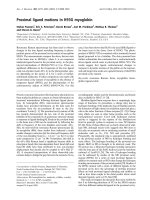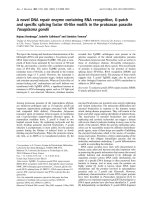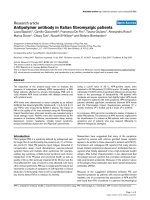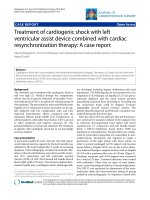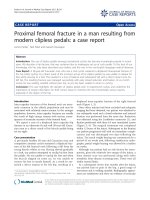Báo cáo y học: "Proximal myopathy in lacto-vegetarian Asian patients responding to Vitamin D and calcium supplement therapy - two case reports and review of the literature" ppt
Bạn đang xem bản rút gọn của tài liệu. Xem và tải ngay bản đầy đủ của tài liệu tại đây (262.48 KB, 3 trang )
CAS E RE P O R T Open Access
Proximal myopathy in lacto-vegetarian Asian
patients responding to Vitamin D and calcium
supplement therapy - two case reports and
review of the literature
Hood Thabit
1*
, Maurice Barry
2
, Seamus Sreenan
3
and Diarmuid Smith
1
Abstract
Introduction: Severe proximal myopathy can occasionally be the first presenting complaint of patients with
osteomalacia. This may lead to investigations and misdiagnosis of a neuromuscular disease, rather than a metabolic
bone disease.
Case presentations: We present here two cases of severe proximal myopa thy in patients who were both of South
Asian origin and lacto-vegetarians: a 31-year-old Indian man and a 34-year-old Indian woman. In both cases, their
clinical symptoms fully resolved following vitamin D and calcium replacement therapy. These patients were at risk
of osteomalacia due to their dietary intak e and ethnicity. The role of dietary intake and sunlight exposure in the
development of osteomalacia in certain ethnic groups living in Western Europe is reviewed here.
Conclusion: These two cases emphasize the importance of recognizing osteomalacia in at-risk individuals, as the
condition is reversible and easily treated with vitamin D and calcium supplementation. It may also help avoid
prolonged and unnecessary investigations of these patients.
Introduction
Osteomalacia can present for the first time in some
patients as severe muscle weakness and difficulty walk-
ing. Proximal myopathy can be present in up to 13% of
patients with osteomalacia [1]. This may lead to investi-
gations and misdiagnosis of neuromuscular disease,
rather than a metabolic bone disease. It is therefore
important in patients known to be at risk of vitamin D
deficiency to consider a diagnosis of osteomalacia, as it
is easily treatable and reversible. We present here two
cases of vitamin D deficiency-induced myopathy.
Case presentations
Case 1
A 31-year-old India n man, a lacto-vegetarian living in
Ireland for five years, presented to our Accident and
Emergency department with a two-day history of upper
and lower limb tetany. He had a one-year history of
increasing bilateral lower limb weakness, which had pro-
gressed to the stage where he wa s not able to stand
unaided. He had been referred six months previously to
a neurologist, where investigations included a no rmal
magnetic resonance imagining of his b rain and spinal
cord and negative acetylcholine receptor antibodies.
Electromyography studies as well as muscle biopsies of
the quadriceps were non-specific (histology showed
minimal type 2 fibre atrophy). On examination, he had
significant proximal muscl e weakness of both lower
limbs and a waddling gait. The rest of the clinical exam-
ination, including a neurological examination, was nor-
mal. Laboratory investigations on admission showed
that he was hy pocalcemic, with a corrected total serum
calcium of 1.43mmol/L (normal range 2.12-2.62mmol/L)
and hypophosphatemic, with 0.70mmol/L (normal range
0.8-1.5mmol/L). Serum parathyroid h ormone (PTH)
(Elecsys 2010 analyser, Roche) was markedly elevated at
595pg/mL (normal range 15-65pg/mL), as was alkaline
phosphatase with 254U/L (normal range 38-126U/L).
* Correspondence:
1
Academic Department of Endocrinology, Beaumont Hospital, Dublin, Ireland
Full list of author information is available at the end of the article
Thabit et al. Journal of Medical Case Reports 2011, 5:178
/>JOURNAL OF MEDICAL
CASE REPORTS
© 2011 Thabit et al; licensee BioMed Central Ltd. This is an Open Access article distributed under the terms of the Creative Commons
Attribution License ( which permits unrestricted use, distribution, and reproduction in
any medium, provided the original work is properly cited.
Serum magnesium, renal profile, complete blood count,
vitamin B12 and thyroid function tests were all normal.
Serum 25-hydroxyvitamin D (Immunodiagnostic Sys-
tems, radio-immunoassay) was 5.5nmol/L (seasonal
reference range > 50 nmol/L). Plain radiographs of his
femur and isotope bone scans were normal. A diagnos is
of osteomalacia was made and he was started on ergo-
calciferol 40,000IU daily for one w eek, then reduced to
twice weekly. He was also started on oral calcium sup-
plements. Following three weeks of therapy his serum
calcium level, alkaline phosphatase and PTH levels
started to normalize and he was able to walk unaided.
Case 2
The second case is of a 34-year-old woman from India
living in Ireland for nine years. She was a lacto-vegetar-
ian with no significant past medical history. She com-
plained of aches and pains in her pelvic region for the
previous four years and was referred to a rheumatologist
comp laining of proximal muscle weakness and difficulty
walking. Her symptoms transiently i mproved when she
went to ba ck to India for holidays, but reappeared upon
returning to Ireland. On physical examination she had
significant proximal myopathy and a waddling gait.
Serum corrected total serum calcium was low at 2.04
mmol/L with elevated alkaline phosphatase (355U/L)
and PTH (104 pg/ml) levels. Her serum 25-hydroxyvita-
min D was low (16 nmol/L, seasonal reference range >
50) with a normal fastin g serum magnesium and phos-
phate of 1.18 mmol/L (normal range 0.87-1.45 mmol/L).
Complete blood counts, B12, thyroid function tests, ery-
throcyte sedimentation rate and an auto-antibody screen
were all normal. Plain film radiogr aphy and isotope
bone scans showed no abnormality. As in the first case,
a diagnosis of osteomalacia was made based on the clin-
ical and biochemical findings. Medical treatment was
initiated, consisting of ergocalciferol 40,000IU once daily
for one week followed by twice weekly, together with
calcium supplementation. Her serum biochemistry
values normalized, together with her clinical symptoms.
Discussion
Osteomalacia is a disorder of osteoid mineralization
characterize d biochemically by hypocalcaemia, hypopho-
sphotemia, hypovitaminosis D, raised serum alkaline
phosphatase and secondary hyperparathyroidism [2].
Failure to mineralize new bone matrix leads to an
increase in both the surface extent and thickness of
osteoid seams. However these changes can only be
detected on bone biopsies. Osteomalacia is especially pre-
valent in certain groups of the general population, such
as in non-Caucasian immigrants living in Western Eur-
ope [3]. In these patients studies have shown that
reduced synthesis of 25-hydroxyvit amin D, due to lack of
sun light exposure, and dietary insufficiency of vitamin D
appear to be the main causes of osteomalacia [4,5]. The
occurrence of osteomalacia can also be related to varying
degrees of vegetarianism. Lacto-vegetarians (vegetarian
diet which includes dairy products, but excludes eggs)
are at greater risk of osteomalacia than ovolacto-vegetar-
ians (vegetarian diet which includes dairy products and
eggs) [6]. Both our cases were at increased risk of vitamin
D deficiency for two reasons. First, both were South
Asians living in a high latitude country where they would
have reduced skin production of vitamin D due to higher
melanin content, coupled with r educed sunlight expo-
sure. Second, although milk in Ireland is fortified with
vitami n D, both patients had limited intake of other diet-
ary sources of vitamin D such as oily fish and eggs. They
also consumed unleavened breads, such as chapati,
almost daily. Un leavened bread contains p hytic acid,
which impairs calcium absorption and therefore may
account for the severity of presentation of vitamin D defi-
ciency in both our cases [7].
The clinical symptomatology of vitamin D deficiency
can vary, but should not be missed by clinicians due to
the potential reversibility of the associated symptoms,
including myopathy. One of the earliest accounts of
osteomalacia associated with profound muscle weaknes s
was by a French surgeon named Jean Louis Petit in
1726. As osteomalacia is the clinical endpoint of vitamin
D deficiency, the proxi mal myopathy observed in these
patients presents as a result of this deficiency. The sali-
ent features in vitamin D deficiency related my opathy
are the proximal distribution, the waddling gait, and
pain and discomfort due to muscular ef fort. Both cases
demonstrated these findings clinically. The muscle
weakness may develop insidiously over years and
patients are frequently referred to different medical spe-
cialists in an attempt to make the diagnosis. In our first
case the patient had undergone extensive neurological
investigations that did not include measurement of his
serum calcium or vitamin D levels.
The role of calcium and vitamin D in muscle function
may largely explain the profound muscle weaknesses
experienced by these patients. It is well recognized that
both intra- and extra-cellular calcium are c ritically
important for muscle cell contractility [8]. Experimental
studies have also shown skeletal muscle contains vitamin
D receptors that specifically bind 1,25(OH)D3 and modu-
late various transcription factors in muscle cells [9,10].
These factors then mediate muscle cell proliferation and
differentiation into mature muscle fibers. Initiation of
vitamin D and calcium supplementation once osteomala-
cia is diagn osed can lead to significant improvements of
myopathy and other accompanying symptoms [1]. How-
ever, it may take several weeks before the patient’s symp-
toms fully recede. Elevated PTH levels in vivo ar e known
to display neurotoxic effects [11]. This may also have
Thabit et al. Journal of Medical Case Reports 2011, 5:178
/>Page 2 of 3
contributed to the muscle weakness in our patients.
Replacement with ergocalciferol and calcium supplemen-
tation resulted in an almost immediate clinical recovery
and biochemical normalization of the serum calcium,
alkaline phosphatase, PTH and 25-hydroxyvitamin D
levels in both of our cases.
Conclusion
These two case reports highligh t the importance of con-
sidering vitamin D deficiency in patients presenting with
proximal myopathy, especially in those known to belong
to high risk groups. A correct diagnosis can help avoid
prolonged and nee dless investigations for these patients,
as the condition is reversible and easily treated with
vitamin D and calcium supplementation.
Consent
Written informed consent was ob tained from both
patients for publication of this case report. A copy of
the written consent is available for review by the Editor-
in-Chief of this journal.
Abbreviations
1,25(OH)D3: 1,25 Dihydroxyvitamin D3; PTH: parathyroid hormone.
Author details
1
Academic Department of Endocrinology, Beaumont Hospital, Dublin,
Ireland.
2
Department of Rheumatology, Connolly Memorial Hospital, Dublin,
Ireland.
3
Department of Endocrinology and Diabetes Mellitus, Connolly
Hospital, Dublin, Ireland.
Authors’ contributions
HT was responsible for data analysis, the literature search and preparation of
the manuscript. MB participated in the data analysis and contributed in the
preparation of the manuscript. SS and DS supervised the study and edited
the manuscript. All authors have read and approved the final manuscript.
Competing interests
The authors declare that they have no competing interests.
Received: 16 February 2010 Accepted: 13 May 2011
Published: 13 May 2011
References
1. Al-Said YA, Al-Rachad HS, Al-Qahtani HA, Jan MM: Severe proximal
myopathy with remarkable recovery after vitamin D treatment. Can J
Neurol Sci 2009, 36(3):336-339.
2. Harris WH, Heaney RP: Skeletal renewal and metabolic bone disease. N
Engl J Med 1969, 280(6):303-311.
3. Dunnigan MG, Paton JP, Haase S, McNicol GW, Gardner MD, Smith CM:
Late rickets and osteomalacia in the Pakistani community in Glasgow.
Scott Med J 1962, 7:159-167.
4. Swan CH, Cooke WT: Nutritional osteomalacia in immigrants in an urban
community. Lancet 1971, 2(7722):356-359.
5. Stephens WP, Klimiuk PS, Warrington S, Taylor JL, Mawer EB: Seasonal
changes in serum 25-hydroxyvitamin D concentrations among Asian
immigrants. Clin Sci (Lond) 1982, 63(6):577-580.
6. Henderson JB, Dunnigan MG, McIntosh WB, Abdul Motaal A, Hole D: Asian
osteomalacia is determined by dietary factors when exposure to
ultraviolet radiation is restricted: a risk factor model. Q J Med 1990,
76(281):923-933.
7. Wills MR, Phillips JB, Day RC, Bateman EC: Phytic acid and nutritional
rickets in immigrants. Lancet 1972, 299(7754):771-773.
8. Frank G: Calcium and other divalent ions in the contraction of skeletal
muscle. Muscle Pergamon Press Oxford 1965, 155-156.
9. Bischoff HA, Borchers M, Gudat F, Duermueller U, Theiler R, Stähelin HB,
Dick W: In situ detection of 1,25-dihydroxyvitamin D3 receptor in human
skeletal muscle tissue. Histochem J 2001, 33(1):19-24.
10. Costa EM, Blau HM, Feldman D: 1,25-Dihydroxyvitamin D3 receptors and
hormonal responses in cloned human skeletal muscle cells.
Endocrinology 1986, 119(5):2214-2220.
11. Kobayashi H, Baba H, Kato H, Kudo Y: The neurotoxic effects of
parathyroid hormone in vivo. J Pharmacol Sci 2003, 91(Suppl 1):192.
doi:10.1186/1752-1947-5-178
Cite this article as: Thabit et al.: Proximal myopathy in lacto-vegetarian
Asian patients responding to Vitamin D and calcium supplement
therapy - two case reports and review of the literature . Journal of
Medical Case Reports 2011 5:178.
Submit your next manuscript to BioMed Central
and take full advantage of:
• Convenient online submission
• Thorough peer review
• No space constraints or color figure charges
• Immediate publication on acceptance
• Inclusion in PubMed, CAS, Scopus and Google Scholar
• Research which is freely available for redistribution
Submit your manuscript at
www.biomedcentral.com/submit
Thabit et al. Journal of Medical Case Reports 2011, 5:178
/>Page 3 of 3


